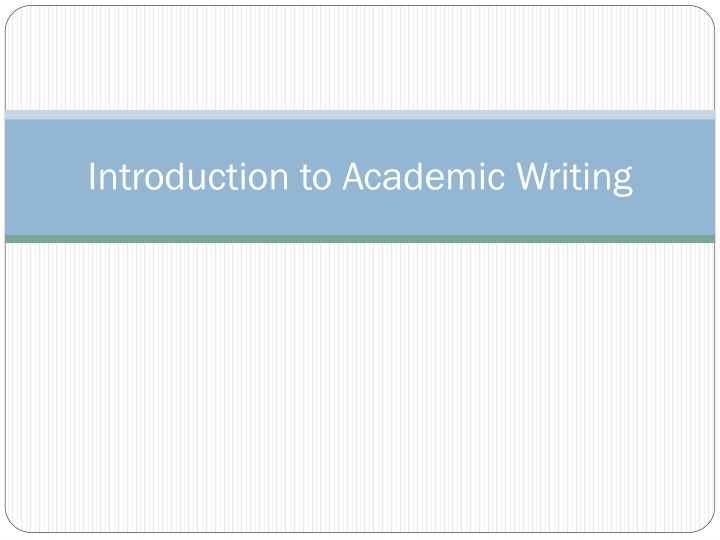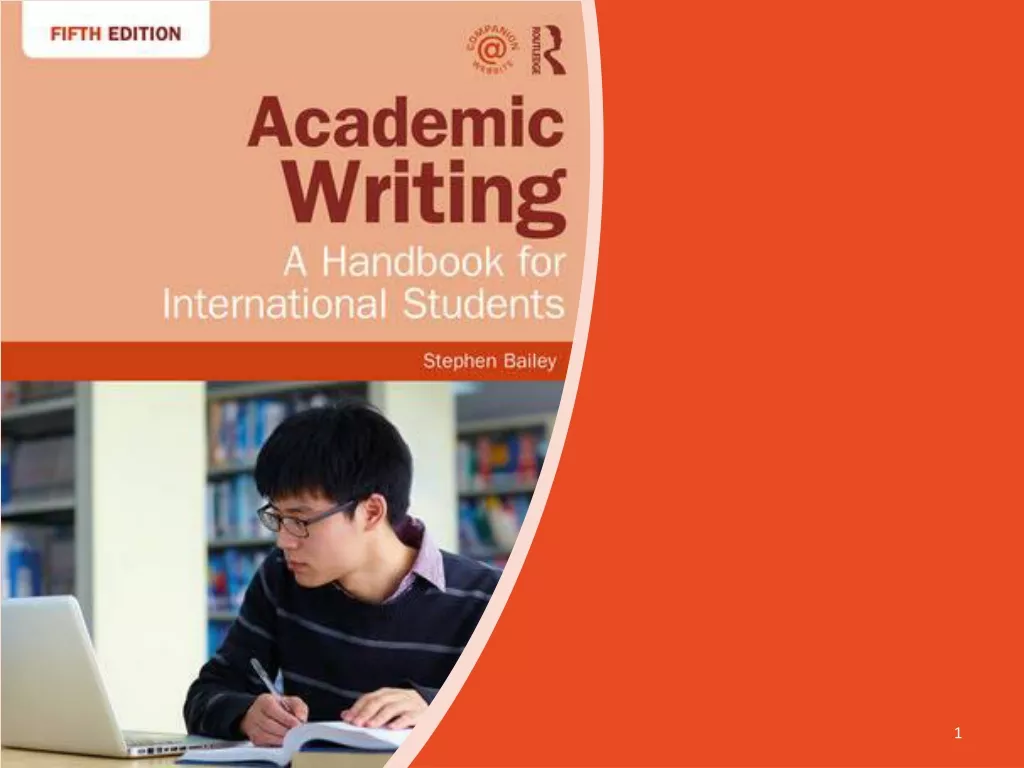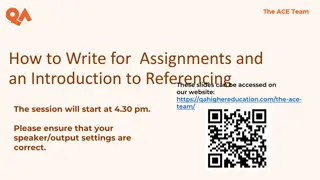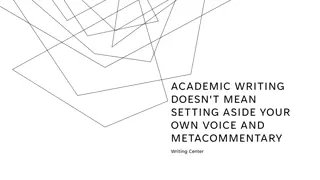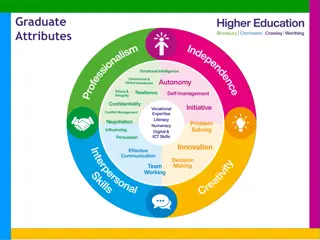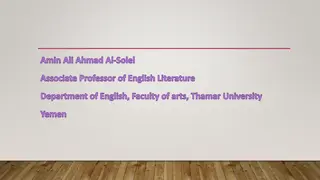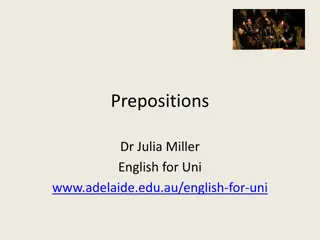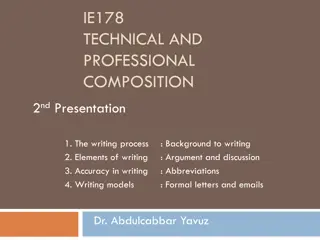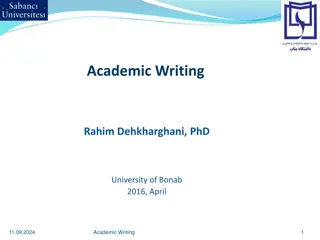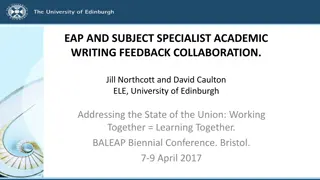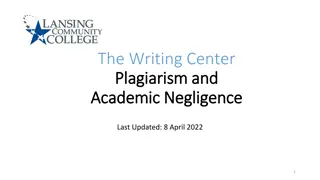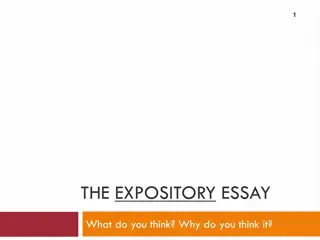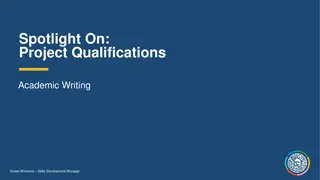Introduction to Academic Writing
Academic writing is a crucial form of communication that requires meticulous planning, precise language mastery, and adherence to conventions. Learners, especially English language learners, may find it challenging due to the need for both linguistic skills and academic knowledge. Understanding the differences between writing in L1 and L2 is essential for successful writing. Academic writing involves presenting ideas logically and systematically to inform, engage, and persuade readers within a scholarly dialogue.
Download Presentation

Please find below an Image/Link to download the presentation.
The content on the website is provided AS IS for your information and personal use only. It may not be sold, licensed, or shared on other websites without obtaining consent from the author.If you encounter any issues during the download, it is possible that the publisher has removed the file from their server.
You are allowed to download the files provided on this website for personal or commercial use, subject to the condition that they are used lawfully. All files are the property of their respective owners.
The content on the website is provided AS IS for your information and personal use only. It may not be sold, licensed, or shared on other websites without obtaining consent from the author.
E N D
Presentation Transcript
Definition of Writing Definition of Writing Writing is a visual form of communication that involves conventions and rules recognized and understood by both writers and readers. However, writing in L1 and L2 differs. While writing in L1 seems to be more systematic and spontaneous, in L2 it becomes more of a conscious process (Silva 1993). Whether in L1 or L2 writing is a complex cognitive process that requires employing memory, appropriate language, and thinking faculties (Kellogg 2001). Furthermore, it requires planning, text-generation, and reviewing using meta- cognitive powers.
In order to be a succesful writer, learners need to master the language they use in writing, master the accurate writing stages such as planning, writing, and reviewing, and adopt the suitable writing approach to writing.
Academic Writing Academic Writing Academic writing is an important genre of writing in the field of English for academic purposes. It is the medium in which knowledge is demonstrated, documented, and passed on. It the process of writing analytically with the purpose of presenting information that depicts a thorough understanding of a certain subject.
Academic writing relies on presenting ideas in a rational, organized, systematic, and logical way. rational Academic writing organized systematic logical
. Informs Enable readers engage critically in a scholarly dialogue analyzes persuades Straightfoward manner
Linear Recursive Following a well- organized structure You may repeat certain ideas You may avoid following the steps strictally Following strict steps and order
English language learners may find academic writing challenging because they have to acquire not only linguistic skills, but also discourse conventions and knowledge content of the academy (Canagarajah 147).
2. Some differences between Academic 2. Some differences between Academic writing and other writing contexts writing and other writing contexts Interpersonal/ intrapersonal writings Academic writing
Interpersonal and Intrapersonal Settings Interpersonal and Intrapersonal Settings of Writing of Writing emails or messages to a friend record and reflect on event and situations that happened to you in your personal diary
Interpersonal and intrapersonal settings of writing no need to follow an organized structure or development of the text, be formal, or adhere to the rules of punctuation and grammar can be written down immediately and spontaneously without organization or planning. personal judgments and evaluations/ personal stories and reflections measured by your feelings and thoughts.
Academic writing Academic writing Refers to all formal written pieces based on facts and reliable data The text should have a well- organized structure: introduction, body, and conclusion be formal and follow rules of punctuation and grammar Cite the published works you consulted
3.Myths about Academic Writing 3.Myths about Academic Writing 1. Many think that writing is a linear process, while in fact it is recursive. 2. Writing is an immediate product. 3. Some got it; I don t ! Some think that the writing the skill is a fixed ability that cannot be controlled. 4. Mastering grammar rules equals good writing. 5. the Five Paragraph Essay is must. 6. Writers in academic contexts are often invited to never use the I
4. The Nature of Academic Writing Academic writing Special training Thorough understanding Processes Requirements
According to Zhu (2004), academic is a specialized literacy that consists of the ability to use discipline-specific rhetorical and linguistic conventions to serve the purposes of the writer (p.29).
A pillar of formal education L2 Students In higher education contexts New ways of writing (Academic writing) Primary medium to access, shape, acquire, and transmit knowledge
Lillis and Turner as well as Ferris and Hedgcock highlight the importance of academic writing; Formal and intensive instruction of academic writing Linguistic and rhetorical forms Components Conventions
Linguistic and technical details Academic discourses in a particular discipline academic writing
According to Hyland (2004) academic writing literacy requires the combination of structural and linguistic knowledge across different disciplines in higher educational settings. It enables students not only to frame their acquired knowledge, but most importantly to appropriately share and communicate this knowledge with different members of the same academic domain. It promotes new thinking as well as discursive and communicative practices. nowadays, academic writing has become an independent field of inquiry due to the intersection of various domains in that specific genre of writing.
5. Paradoxes of Academic Writing 5. Paradoxes of Academic Writing It is not only necessary to recognize the possible pushes and pulls associated with the writing process; but most importantly, it is inevitable to explore the various paradoxes about academic writing due to the insurmountable writing blocks that stand imposingly between the writer and his efforts to write. Paradox 1: The starting versus finishing paradox Paradox 2: The originality versus convention paradox Paradox 3: The logic versus emotion paradox Paradox 4: The easy versus difficult paradox Paradox 5: The public versus private paradox
The Starting Versus Finishing Paradox The Starting Versus Finishing Paradox Starting to write a project, especially a long one, is completely different from finishing it because it requires perseverance and persistence. Furthermore, the initial stages and the maintenance as well as the closure of the writing task require a different set of dynamics and skills. Yet,both exist together
The Originality Versus Convention The Originality Versus Convention Paradox Paradox It is about the necessity of being original, innovative and very creative in articulating your own ideas, but at the same time relying on other experts and academic voices in order to support your writing. Academic writers, often, become terrorized by the related literature in ways that make them either less confident about they own ideas, or obsessed with defending their personal ideas as completely new and valuable . In order to solve the originality versus convention paradox, academic writers should be encouraged to be informed about related literature but not limited to it and guided by the prevailing ideas but not enslaved by them.
The Logic Versus Emotion Paradox The Logic Versus Emotion Paradox This paradox is related to the writers himself. Academic writers are often required to be very logical and objective vis- -vis the nature and contribution of their writing while neglecting and suppressing the emotional and psychological dimension that inevitably affects either positively or negatively the writing process. The logical dimension employed in developing a written piece will inevitably generate a disparate set of emotional reactions The final draft of a written work does not exhibit the emotional ups and downs, frustrations, anxieties, joys, or satisfaction the writer has gone through An awareness about the logical dimension is not enough. The emotional one is important because it creates a more self-aware and reflective academic writer.
The Easy Versus Difficult Paradox The Easy Versus Difficult Paradox According to Peter Elbow, it is difficult not because of the writing mechanisms, styles, elements or requirements, but because of the writer s attitude towards writing. It becomes hard because of the all the things that the writer thinks about when engaged in writing like the type of audience that might read what is written, the types of questions that might be asked or things that might be said about the written product and about the writer, and the kinds of remarks, evaluation, or reward the writer might or might not obtain. However, once the writer ignores these speculations and focuses more on the actual writing,the other side of the paradox triumphs. A useful strategy for academic writers to solve the difficult versus easy paradox is to try to control when to perceive the writing process easy or difficult.
The public versus private paradox The public versus private paradox The private and the public dimensions should go hand in hand, enhance, and restrain one another. In reality, however, it is very challenging for academic writers to shift from the private to the public. It is only when creating private personal protected writing spaces and stages that the academic writer practices freely and efficiently his writing and research skills without the fear of engaging in a debate, dialogue or scrutiny and criticism by experts. This personal preparatory phase often equips the academic writer with confidence and proficiency necessary to expose his work to more exacting experts and critics. The personal phase enables novice writers to work on their own self-belief to consider going public in the future. In order to solve this paradox, the academic writer should identify times when either private writing or exposure to public is more fruitful and helpful because after all stagnating at the private phase of writing is underestimated in academic settings.
6. Principles of Academic Writing 6. Principles of Academic Writing 1. Clear purpose: Academic writing is characterized by having a well-determined purpose. The goal of any academic written piece is to answer the question(s) the writer posed at the very beginning of his work. Some written assignments have a pre-determined purpose; for others, you have to choose both the topic and the purpose of the written assignment. In all cases, the purpose of your written work should be clearly set from the beginning. Academic written works generally analyzing/synthesizing,or informing. aim at persuading,
The argument essay outline Functional stages Description (Introduction) Here you usually indicate how you will approach Overall position/ the topic, and provide a statement of the main argument argument (thesis statement/point of view). (Body) Here you put forward sub-arguments with each Sub-arguments and one linking (explicitly or implicitly) to your overall supporting evidence position. Evidence to support main and subargument is presented and evaluated. Further arguments and evidence may then be presented and evaluated. Counter-evidence may be presented and evaluated, usually negatively. This process continues until the case for your main argument is strong. (Conclusion) Here you provide an overall summary of the Reinforcement of arguments and evidence together with a final overall position/ evaluation. This reinforces the position you took in the introduction argument. References List the works you have mentioned in the text.
The investigative project report outline1 Functional stages Description Aims This stage is a full account of what you were trying to find out and why it was important. If a project proposal was written, then any subsequent changes should be noted and briefly explained. Literature review Here you discuss the ideas which are relevant to your project. This should show that you understand the background issues and theories relating to the project. Methodology This should be a description of the methods used and will include any alterations that became necessary during the conduct of the investigation. Your choice of method should be drawn from or build upon the literature review. An account of your Here you should describe the context in which the the work was carried out and give a concise account of what was done. conduct of Investigation Explain how you addressed any critical issues. It may be written as a first-person narrative or more formally. Findings In this stage give the results of the investigation. How do these relate to issues in the literature? Present examples from the evidence collected to illustrate the points being made. Evaluation Here you need to consider the outcome of the project in relation to the initial aims and questions. Are there ways in which it could be changed and improved if carried out again? What kinds of further investigation could be made to follow up the results or extend the work started? References A list of all sources of material quoted or drawn upon in the project. Appendices Additional data or analysis that supports your aims and findings.
2. Audience Engagement: all types of academic writings are directed to a specific audience. Whatever the type of audience is, make sure that you engage them with your ideas and catch their interest with your writing style. Throughout your work, you should assume that you are addressing experts in your field.Thus,as a writer you should rely on reliable data, analysis, and reasoning to convince your audience.
3. Clear Point of View: Academic writing is by no means about stating and collecting a list of information and summaries of others ideas. Though it is a necessary part to support your idea, your writing should focus primarily on your own original idea and personal perspective about the discussed issue. This is often clearly stated in what is called the thesis statement in the introduction of your written work.
4. Single Focus: any academic written paper should have a central and unique idea. it is unacceptable to include divergent, unessential, or contradictory details. Even in the case of comparative or argumentative papers, you should not only present opposing ideas, but you should respond, analyze, and critique them in a way that consolidates your viewpoint.
5. Logical Organization: academic writing is based on a conventional organizational pattern. It comprises the introduction, body, and conclusion with each part leading to the next. The introduction sets the ground for the whole written work with its emphasis on providing background information and providing the thesis statement, the body contains many interconnected paragraphs each with a topic sentence and all supporting the thesis statement, and the conclusion reminds the readers of the thesis statement and summarizes the findings significance.
6. Strong Support: Though academic writing relies on presenting an original idea, supporting evidence, facts, data are required to corroborate all the topic sentences and thesis statement in the written paper.
7. Clear and Complete Explanations: while academic writers are often invited to consider their readers as experts, they also have to do all the work for them. They should facilitate the reading process with logical, clear, and organized presentation of ideas and information.
8. Effective Use of Research: This is related to the use of source materials that are introduced, analyzed, and cited to support your own argument. These source materials should be academic and of high quality. The effective use of these materials does not consist of just inserting them in your paper, but it is primarily about explaining and discussing their value, difference, or relevance.
9. Correct Referencing Style: Since academic writing relies on using other source materials,it is indispensible to cite them. In order to do so, academic writers should follow the guidelines of one referencing style depending on their discipline. These may be APA, MLA, Chicago, IEEE style. All of them regulate the in-text citations, the reference list, and the text format in general.
10. Writing Style: Though academic writing relies on citing other experts and including some quotations, writers are encouraged to use their own words, style, and language as much as possible. The writing style should be clear, concise, and precise. Grammar, spelling, punctuation or vocabulary mistakes are not accepted in academic writing.
Register in academic writing refers to a range of linguistic aspects including formality, sentence structure and specialist terminology. The following are some features of the academic register: High lexical density: Large number of vocabulary items other than verbs per clause (e.g. A significant commitment of time must be made in the production of a lengthy work ). Highly nominal style: Greater use of nouns than verbs to construct meanings and make them compact (e.g. The production of a necessarily involves issues of time management , rather than To manuscript you need to consider how to manage time efficiently ). Impersonal constructions: Subjects or agents of clauses often backgrounded (e.g. It is often difficult to incorporate an additional workload into an already heavy agenda ,rather than You may find it difficult to ). Hedging and emphasising:Verbs and phrases used to modify statements made (e.g.may,might,must,need to,it seems that,possibly,probably). manuscript produce a
Activity : Formality in writing The following two extracts both introduce the problem of how to plan a schedule when working on a manuscript. There are, however, major variations in register between them.Your task is to analyse the selections by answering the following questions. 1Who is a likely audience for each selection? 2Why would one selection be preferable over another? 3What argument would the author give for choosing one over another? 4What aspects of language are involved in achieving the different registers? A.Looking ahead and planning your schedule So, you have a manuscript in your life? As demanding as a jealous lover and as burdensome as unpaid debts, the weight of this new presence can be difficult to cope with when you may already be juggling family, a job, studies, friends, and perhaps a hobby or exercise programme.A little planning can make the load easier to bear B.Time management and manuscript production The production of a manuscript necessarily involves issues of time management. A significant commitment of time must be made in the production of a lengthy work therefore several factors should be considered from the onset. It is often difficult to incorporate an additional workload into an already heavy agenda, and so, time management planning is essential to successful completion of the project (Zuengler, 1999)
Finally, the most important principle is that you should always follow the directions of your instructor. Whether it is your teacher or supervisor, following your instructor s directions does not only train you efficiently but also enables you to get the most from the assignment or writing activity.
Styles and Types of Academic Writing Styles and Types of Academic Writing In academic writing, there should be a clear distinction between the writers style and the style of the written piece. While the former, generally, refers to the writer s personal perceptions and voice; the latter indicates the purpose for which the written product has been developed.Furthermore, the written product is shaped by its aim and should fall under one of the following categories and types. These are expository,descriptive,narrative,and persuasive.
1.The Expository type 1.The Expository type It is the most used type in academic writing, often named as Informational writing . it aims at explaining sequentially and thoroughly a certain issue. The writer investigates a topic by searching for the existing evidence, and expounding it to inform readers. This type is objective, subject-oriented, and fact-based without an eminent voicing of the writer s point of view (William,2001). Since the focus of this type is information, it employs all means of explanation and clarification including figures, statistics, images, etc. it also employs comparisons, analyses, cause/effect,and examples. Expository writing is used, to name only few, in textbook writing, technical and scientific writings,and how-to articles. definitions, classification,
Use the POET the POET method to organize your expository essay like a boss:
Revising your Expository Essay: Question to Answer Does it give an unbiased analysis of facts and examples? Do you communicate the information clearly and logically? Are there any unnecessary details you could omit for the essay to sound more focused? Are all the sentences clear? Is the word choice precise? Do you choose logical transitions between sentences and paragraphs for readers to understand the information better? Do you restate the thesis and supporting ideas in the concluding paragraph of your essay?
2. Persuasive Writing: 2. Persuasive Writing: This type of writing, also called argumentative writing, entails the writer s opinions and points of view about a particular topic. More than taking a stand, the writer in persuasive writing is required to convince the readers about his standpoint. Persuasion relies on employing solid evidence,convincing argument,appeal to reason,and experts opinions (Laurie,2003). In persuasive writing,the writer does not only need to take a clear stand right from the beginning, but is also encouraged to know the type of his/her audience and their positions about the issue under discussion. The writer should build the arguments in progression, so that he/she will move from the least important to the most important one. This gradation will attract the readers attention and will convince them that the writer is standing his ground by the end of the paper. Disproving the opposing claim is one of the most effective ways to prove your viewpoint. Thus, a good writer will be searching for resources not only to support his point of view, but also to refute the opposing positions as well. In academic writing,this approach is called refutation. Persuasive writing is used in recommendations,reviews of books,etc. editorial newspapers, letters of
Structure of the persuasive Structure of the persuasive essay essay The hook captures the reader s attention The thesis states the writer s assertion (belief) about the topic The supporting arguments (logos, pathos, ethos) convince the reader that the thesis is correct Optional counter arguments respond to reader concerns and objections The conclusion restates the thesis (comes back to the point)
Types of Supporting Arguments Ethos-an appeal to do the right thing File:Unclesamwantyou.jpg http://en.wikipedia.org/wiki/Uncle_Sam http://marvel.com/images/gallery/story/15172/images_from_own_a_piece_of_the_captain_america_movie/image/857368
Types of Supporting Arguments Logos an appeal to logic Often contain expert testimony Often contain statistical information Suggest that the product is the logical or right choice
Types of Supporting Arguments Pathos-an appeal to the emotions http://46664.net/56/aspca-the-american-society-for-the-prevention-of-cruelty-to-animals/
